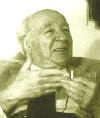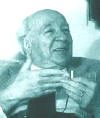|

|
abstract:
The goal
of this talk is to present applications to two-dimensional lattice
models of the so-called 'parafermionic' observables. We will focus on
two examples: self-avoiding walks and random-cluster models.
Firstly, we will prove one of the famous conjectures made by Nienhuis
regarding the number of self-avoiding walks on the hexagonal lattice.
More precisely, we will show that the number an of
self-avoiding walks of length n (starting at the origin) satisfies
limn 1/n log an
= Sqrt(2 + Sqrt(2) ).
This
first example will give us the opportunity to introduce parafermionic
observables and to present conformal invariance conjectures (joint work
with S. Smirnov).
Secondly, we will generalize these vertex operators to random-cluster
models and we will discuss how one could use these observables to prove
important conjectures on the models.
|
|

|
abstract:
The
attempt to model real-life complex networks such as the World Wide Web
and, more recently, on-line social networks, has led to interesting new
random graph models. I will review some lesser known models and the
graph-theoretic properties that arise from them. One such model is the
protean graph model, proposed by Luczak and Pralat. This is a dynamic
model of constant size: in each time step, one vertex dies and another
is born. Link probability is based on a ranking of the vertices, where
ranking can be based on various criteria.
Two important goals of analysis of complex networks are the
identification of communities and the recognition of "similar"
vertices. In this context, spatial graph models arise naturally.
Vertices are assumed to be embedded in a latent space, and link
formation is influenced by the position of the vertices in the space.
The spatial preferred attachment model (SPA) model was proposed as a
model that is based on a hidden spatial reality, but still generating
graphs whose properties are as observed in real-life networks.
The principles on which the protean graph model and the SPA model can
be combined to form the geo-protean model. The geo-protean graph is
proposed as a model for social networks, and exhibits many of the graph
properties observed in on-line social networks.
|